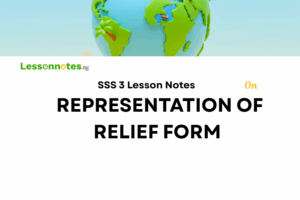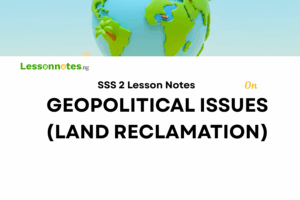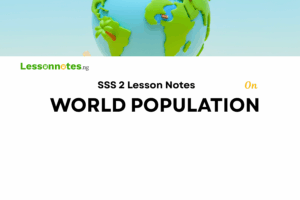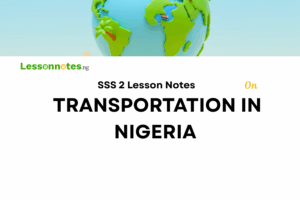Map Readings SS3 Geography Lesson Note
Download Lesson NoteTopic: Map Readings
SPECIFIC OBJECTIVES: At the end of the lesson, pupils should be able to
- Explain maps and state with examples of different types of maps and their uses
- Identify and describe different types of map scales and their attributes.
- State the merits and demerits of the various types of scales.
- Convert map scale from one form to another.
INSTRUCTIONAL TECHNIQUES:
- Identification,
- explanation,
- questions and answers,
- demonstration,
- videos from the source
INSTRUCTIONAL MATERIALS:
- Videos,
- loudspeaker,
- textbook,
- pictures
NOTE
INTRODUCTION TO BASIC CONCEPTS IN MAP READING
A Map
A map is a visual representation of a geographical area, typically depicting the spatial relationships between various elements such as landforms, cities, roads, and geographical features. Maps can be used to navigate, convey information about the physical environment, display political boundaries, or illustrate thematic data. They come in various types, including topographic maps, road maps, political maps, and thematic maps, each serving different purposes based on the information they convey.
Types of maps
There are different types of maps along with explanations and examples of their uses:
- Political Maps: Political maps are visual representations of political boundaries and features, emphasising the administrative divisions of countries, states, and cities. These maps typically highlight national borders, capitals, major cities, and sometimes important physical features like rivers and mountains. An example is a world map outlining national borders and capital cities.
- Physical Maps: This is a type of map that focuses on illustrating the natural features of a geographical area, emphasising physical characteristics such as landforms, bodies of water, vegetation, and elevation. These maps provide a visual representation of the Earth’s surface, highlighting the terrain and natural features. An example is a map illustrating the physical landscape of a region, showcasing terrain and elevation.
- Topographic Maps: A topographic map is a detailed and accurate representation of the Earth’s surface that showcases the physical features of a specific area. Unlike general physical maps that focus on broad landforms, topographic maps provide more detailed information, emphasising the elevation, contours, and relief of the terrain. An example of a topographic map is the USGS topographic map for hikers, indicating trails, peaks, and valleys.
- Thematic Map: Rather than attempting to map the landscape or help to show you where to go, thematic maps are designed instead to highlight information on specific topics. It could be anything from geology to population density or weather, and we’ve even seen thematic maps used to track the locations of whales. Companies like Esri use thematic maps to make a massive difference to businesses, governments and other organisations around the world, combining geography with information like our smart traffic services to allow more efficient decisions to be made. An example is a Population Density Map which illustrates the concentration of people in different regions using colour gradients.
Uses of Map
- To locate places on the earth
- To represent a geographical area
- Road maps guide the road users on the direction and distance they have to travel to get to their destination
- A map gives information about a particular place. E.g. African map, Nigerian map, etc.
- Weather maps provide the required information to be used by aeroplane pilots and ship captains
- Plan maps are used in buildings and construction
Types of map scales and their attributes
There are various types of map scales used to represent the relationship between distances on a map and corresponding distances on the Earth’s surface. Below are some common types:
- Linear Scale (or Bar Scale):
A linear scale, also known as a bar scale, is a graphical representation on a map that illustrates the relationship between distances on the map and the actual distances on the Earth’s surface. Its main attributes include: Representation, Measurement, Units, Accuracy, Placement etc
Merits of Linear Scales
- Linear scales allow for direct measurement of distances on the map, providing a straightforward and intuitive method for users.
- The graphical representation of a linear scale as a bar or line is visually clear, making it easy for users to understand and use.
- Linear scales are specific to one unit of measurement, reducing potential confusion for users.
- Linear scales can be placed in various locations on a map without interfering with other features.
Demerits of Linear Scales
- The precision of linear scales may be limited, especially on small-scale maps, making accurate measurements challenging.
- Linear scales are confined to a single unit of measurement, requiring multiple scales for maps using different units.
- Statement Of Scale: This is a scale usually expressed as the ratio of map size to the actual size of an area in words. The statement scale can be stated in different ways. For example, one centimetre to represent two kilometres or 1cm to 1 km. This means that 1 cm represents the distance on the map while the last figure, 1 km represents the distance on the ground. Note, that it is not correct to say that one centimetre is equal to one kilometre or 1cm =1km.
How to Use Statement of Scale
- Note the two places involved
- Measure the distance between the two places and relate it to the scale. e.g. If the scale of a map is 2cm to 1km, what is the ground distance if the distance between the two places on the map is 10cm?
Solution:
Map distance = 10cm
Ground distance =?
Map scale = 2cm to 1km
Since 2cm = 1km
Therefore: 10cm = 10/2 X 1km = 5km.
The ground distance between the two places is 5 km.
Merits of statement of scale
- It is simple and easy to understand
- It helps to get actual distance on the ground
Demerits of statement scale
- It is difficult to convert
- It is not error-free
- Representative Fraction (RF) or Ratio Scale:
The representative fraction (RF), also known as the ratio scale, is a way of expressing the scale of a map in the form of a ratio or fraction. This scale provides a clear and consistent representation of the relationship between distances on the map and corresponding distances on the Earth’s surface.
In the representative fraction, the scale is expressed as a ratio, where the first number represents the map distance, and the second number represents the equivalent real-world distance. For example:
- An RF of 1:50,000 indicates that one unit on the map represents 50,000 units on the ground.
- An RF of 1/100,000 signifies that one unit on the map corresponds to 100,000 units in reality.
Merits of Representative Scales
- Representative scales are versatile and can be applied to maps of various sizes and scales, providing a consistent method of expressing scale.
- The ratio format of representative scales offers a universal understanding of the relationship between map distances and real-world distances.
- Users can easily compare maps with different representative scales to gauge relative sizes.
Demerits of Representative Scales
- Understanding representative scales may require some interpretation, which can be less intuitive for certain users.
- The ratio information on representative scales is often presented in a small font, which may be overlooked by map readers.
Convert map scale from one form to another
- Write out the scale clearly
- Write out the two parts of the scale in the same unit; usually in the lower unit.
- Write the scale as a fraction with the map measurement as the numerator, and the ground measurement as the denominator
- Divide through if need be before expressing the final answer as a ratio
Examples 1: Convert the following statement scales to Ratio scale
- 2cm to 1km
- 1 cm to 1km
Solution
- 2cm to 1km
2cm to (1 km × 100,000) = 2cm to 100,000cm
Expressing as a fraction and dividing through
2cm / 100,000cm = 1/50,000
Thus 2cm to 1km is 1:50,000 in R. F
Remember 2cm to 1km may also be written as 1 cm to ½km
- 1 cm to 1km
Convert 1km to cm by multiplying with 100,000
1cm to (1 km × 100,000) = 1cm to 100,000 cm
Expressing as a fraction,
1cm to 100,000cm = 1 cm/100,000cm
Expressing as a ratio
1 cm to 1km is therefore 1:100,000 in R. F
Example 2: Convert the following R. F scales to statement scales
- 1:20,000
- 1:50,000
Procedure :
- Write out the scale clearly
- Divide the ground measurement on the right-hand side of the ratio by 100,000 to convert to km
Solutions :
- 1:20,000
Let’s first divide the measurement by 100,000
Now 20,000/100,000 = ⅕ km
Thus, 1: 20,000 = 1 cm to ⅕ km or 5 cm to 1km
- 1:50,000
Divide the ground measurement by 100,000
Hence, 50,000/100,000 = ½km
Therefore 1:500,000 = 1cm to ½km or 2cm to 1km in the statement scale
EVALUATION:
- What is a Map?
- Give 4 uses of a Map.
- Identify 4 types of maps and explain them
- Convert 1: 100 000 to statement scales
CLASSWORK: As in evaluation
CONCLUSION: The teacher commends the students positively





















